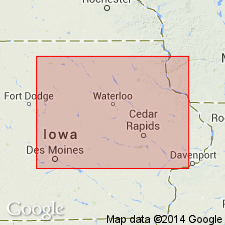
- Usage in publication:
-
- Wapsipinicon Group
- Modifications:
-
- Revised
- AAPG geologic province:
-
- Iowa shelf
- Wisconsin arch
Summary:
Revised from formation to group rank. Includes rocks above the erosional Ordovician and Silurian surface. Underlies Little Cedar Formation (named) of Cedar Valley Group (rank raised). Includes in northern IA (Iowa shelf)-ascending order-the Spillville Formation, Pinicon Ridge Formation (named) and its Kenwood, Spring Grove, and Davenport Members. Includes in east-central IA (Iowa shelf)-ascending order-Bertram Formation, Otis Formation and its [Coggon] and Cedar Rapids Members, Pinicon Ridge Formation and its Kenwood, Spring Grove, and Davenport Members. Type section designated at Pinicon Ridge Park, NE SW SE sec 28, T86N, R6W, Linn Co, IA, where rocks from base of [Coggon] to Davenport are exposed. Top of Davenport is eroded at type. May be as much as 60 m thick. Is about 10 m thick at Pinicon Ridge Park. Consists predominantly of dolomite, limestone and in south part of area some gypsum and anhydrite. Nomenclature charts. Graphic sections. Two major transgressive-regressive depositional cycles represented in this group. Of Middle Devonian, Eifelian and early Givetian age.
Source: GNU records (USGS DDS-6; Denver GNULEX).
For more information, please contact Nancy Stamm, Geologic Names Committee Secretary.
Asterisk (*) indicates published by U.S. Geological Survey authors.
"No current usage" (†) implies that a name has been abandoned or has fallen into disuse. Former usage and, if known, replacement name given in parentheses ( ).
Slash (/) indicates name conflicts with nomenclatural guidelines (CSN, 1933; ACSN, 1961, 1970; NACSN, 1983, 2005, 2021). May be explained within brackets ([ ]).

